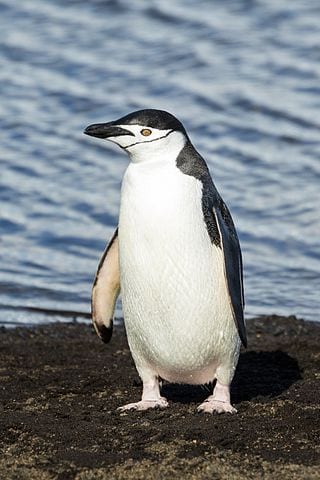Specimen of the Week 335: The Chinstrap Penguin skull
By Jack Ashby, on 23 March 2018
This week’s Specimen of the Week is a guest edition by Front of House Volunteer and UCL Student of History and Philosophy of Science, Leah Christian.
A couple of weeks ago we gave you a skull from the flamingo, a bird that prefers the warmer climes. Now, let’s look at a bird that would feel right at home in the United Kingdom this week…
** The chinstrap penguin skull**
Chinstrap penguins (Pygoscelis antarcticus) live in Antarctica and sub-Antarctic regions. Black and white like many of the other penguins, the chinstrap is easy to identify due to the black band beneath its chin.

Chinstrap penguin. Image: Andrew Shiva / Wikipedia / CC BY-SA 4.0
Chinstrap penguins are capable climbers, choosing to nest in ice-free areas such as rocky slopes. Like the gentoo and Adélie penguins, they build their nests from stones. They either collect these stones from the surrounding area or take the easy option—steal from a neighbour. However they acquire their materials, a well-built nest appears correlated with the successful survival of the offspring. The penguins nest at the same site each year and with the same partner. The adults play equal roles in caring for offspring.
The chinstrap penguin is a thriving species. The total population is approximately eight million with some colonies having up to 100,000 pairs.
More Than a Skull
Museum specimens are not just valuable from an anatomical perspective, they can provide evidence that a particular species was living in a particular place at a particular time; as well as giving an insight into scientists and their work for the period that they were collected. This penguin was collected by the British Antarctic Survey in March, 1966, on Signy Island.
The British Antarctic Survey and Signy Island
The British Antarctic Survey grew out of research and infrastructure established during the Second World War. Funded by the Natural Environment Research Council, it supports research in the polar regions. This research covers everything from ecology, to biology, to meteorology, to oceanography, to geophysics.
Signy Island is a small island in the Southern Orkney Islands off the coast of Antarctica. It is home to the Signy Research Station, which was originally established in 1947 as a meteorological station before being transitioned to biological research in the 1960s. It is also home to a large population of seabirds, including southern giant petrels, gentoo penguins, adélie penguins, and chinstrap penguins. The proximity of the research station to these populations makes it an ideal location for the study of not only the biology of these seabirds but also the ecosystem in which they live. Additionally, since the research station has been in continuous use for decades, it is the source of many long-term studies, which are vital for conservation purposes.
The Importance of Context
The where and when associated with a specimen provides avenues for research which are only just being realized. Scientists are now going into natural history museums to compare organisms collected in the past to current members of the species in order to determine things like how the species is changing or how human activities have impacted a species at different places and times.
In 2017, for example, researchers studied several species of songbirds held in a collection at The Field Museum of Natural History, Chicago, Illinois, USA. They found that the birds collected from highly industrialized areas in the late 19th and early 20th centuries were stained by air pollution. With the birds, they were able to establish a timeline showing air quality from 1880 to 2015 in the USA manufacturing regions.
When the birds were originally collected, no one knew what creative research they would inspire in the future. Who knows what questions this penguin skull might answer?
References
https://www.bas.ac.uk/about/antarctica/wildlife/penguins/chinstrap-penguin/
https://link.springer.com/article/10.1007/BF00239644
https://www.bas.ac.uk/polar-operations/sites-and-facilities/facility/signy/#science
Leah Christian is Front of House Volunteer in the Grant Museum of Zoology, and a UCL student of History and Philosophy of Science.
 Close
Close


